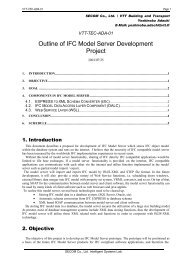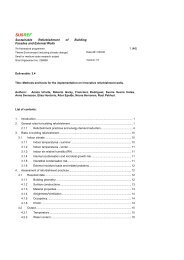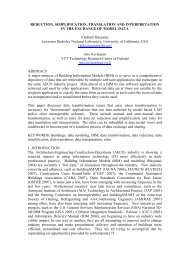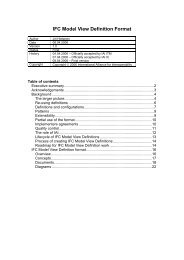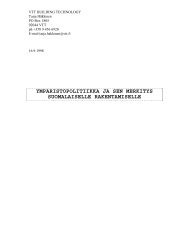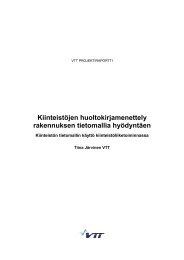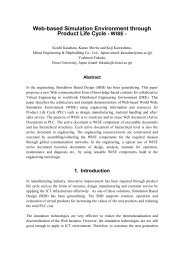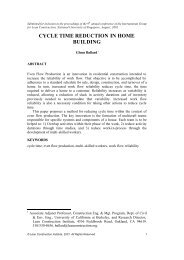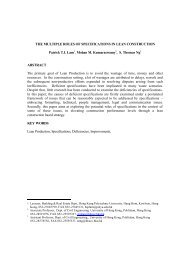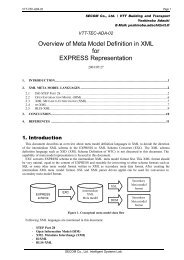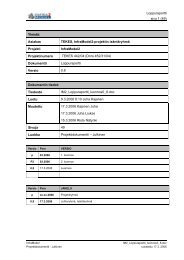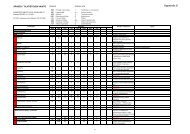Introduction to EON SDK - Construction IT research at VTT
Introduction to EON SDK - Construction IT research at VTT
Introduction to EON SDK - Construction IT research at VTT
Create successful ePaper yourself
Turn your PDF publications into a flip-book with our unique Google optimized e-Paper software.
User Guide<br />
Techniques<br />
inform<strong>at</strong>ion, string tables and bitmaps. It is compiled in<strong>to</strong> a<br />
binary resource th<strong>at</strong> is linked <strong>to</strong> the project output file.<br />
• Toolbar.BMP<br />
This bitmap exists only if you choose the Add cus<strong>to</strong>m command <strong>to</strong><br />
<strong>to</strong>olbar option in the Module Wizard. The bitmap file contains just<br />
three <strong>to</strong>olbar but<strong>to</strong>ns, but you can easily extend it <strong>to</strong> include as<br />
many but<strong>to</strong>ns you'd like.<br />
• ProjectName.DEF<br />
Windows definition file. It contains the exposed entry points of<br />
the ProjectName.DLL.<br />
• ProjectName.IDL<br />
The IDL file of our project. You will add interface and method<br />
definitions here. Microsoft's MIDL compiler will process this file<br />
<strong>to</strong> produce the type library (.tlb) file, in addition <strong>to</strong><br />
ProjectName.h, which is included in ProjectName.CPP.<br />
• ProjectName.H<br />
This file contains interface declar<strong>at</strong>ions for the COM object, i.e.,<br />
<strong>EON</strong> module. The MIDL compiler produces the ProjectName.h file based<br />
on the project's IDL file.<br />
• ProjectName.CPP<br />
This is the main implement<strong>at</strong>ion file for the COM object housing. It<br />
contains source code for the DLL exports, and offers both ATL and<br />
MFC support. (Note the presence of the_Module and theApp global<br />
variables th<strong>at</strong> are there <strong>to</strong> support the use of ATL and MFC<br />
classes.)<br />
• <strong>EON</strong>MODULE.H<br />
This header file contains the class declar<strong>at</strong>ion of your <strong>EON</strong> Studio<br />
module's class CEonModule, which is the class you have <strong>to</strong> modify <strong>to</strong><br />
include module-specific functionality.<br />
• <strong>EON</strong>MODULE.CPP<br />
The CEonModule class is implemented in this file. It may provide<br />
functions for licensing, connecting new views <strong>to</strong> the <strong>EON</strong> Studio<br />
GUI, adding <strong>to</strong>olbars, etc.<br />
• MODULEVIEW.H<br />
This file holds the declar<strong>at</strong>ions of the sub-classed window used as<br />
the module's view.<br />
• MODULEVIEW.CPP<br />
This file contains the source code for the implement<strong>at</strong>ion of the<br />
sub-classed window th<strong>at</strong> your module uses as its view (or as split<br />
views). This is where all displaying of GUI objects for various<br />
d<strong>at</strong>a exposure should be placed. Here, you should also add code <strong>to</strong><br />
support different kinds of module messages (th<strong>at</strong> is, if you have<br />
decided <strong>to</strong> include module message handling in your module).<br />
• README.TXT<br />
This file contains some brief inform<strong>at</strong>ion about each file inserted<br />
in<strong>to</strong> the new project.<br />
28<br />
<strong>EON</strong> <strong>SDK</strong> 2.53.0



